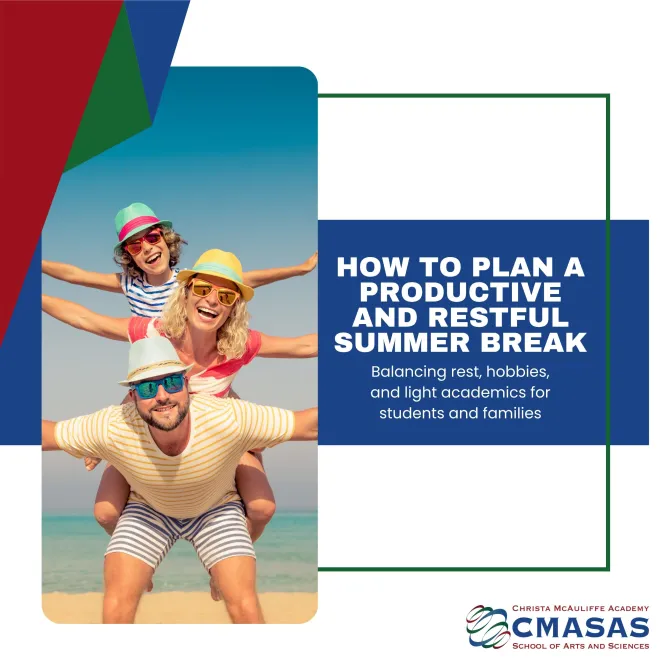HOW TO PLAN A PRODUCTIVE & RESTFUL SUMMER BREAK

As summer approaches, students (and parents!) often find themselves wondering: How can we make the most of this break? It’s tempting to fill every week with activities, trips, or summer school—or, on the flip side, to completely unplug and let the weeks drift by. But what if you didn’t have to choose between rest and productivity?
A balanced summer can leave students feeling refreshed and prepared for the next school year. It can also offer opportunities for personal growth, exploration, and family connection. Here are a few simple tips to help plan a summer break that nurtures curiosity, supports well-being, and leaves room for fun.
1. Redefine "Productivity"
We often think of productivity as checking off academic tasks or staying on a rigid schedule, but it can be so much more than that. For students, being productive over the summer might look like learning something new or engaging with the world in a different way. The key is keeping the mind active in ways that feel meaningful and enjoyable.
That could mean picking up a new hobby like photography, learning to cook, writing a short story, or diving into a stack of novels. Volunteering or participating in a local program can also be a wonderful way to stay engaged. The point is to view productivity through a broader lens—one that encourages creativity, initiative, and joy.
2. Make Space for Rest (and Mean It!)
Rest doesn’t mean laziness—it means giving the body and mind what they need to recover from the busy school year. For many students, the academic calendar is packed with pressure, performance, and limited downtime. Summer should be a chance to reset.
Encourage your child to notice and honor their energy levels. One day they might want to be active and social, while the next they may need solitude or quiet. Provide opportunities for true rest: unstructured time, sleep, digital detoxes, and low-pressure activities. Intentionally planning restful time helps students return to school recharged and ready to learn.
3. Keep a Light Academic Touch
It’s no secret that students can lose some academic ground over the summer. But this doesn’t mean they need to be buried in worksheets. A light, low-pressure academic routine can help maintain skills and build confidence without overwhelming students or cutting into their freedom.
Consider enrolling your child in a short elective or enrichment course focused on something they’re genuinely interested in.* Reviewing key concepts from the past school year or exploring a new subject can also be great ways to stay engaged. For example, students love to take P.E. over the summer when they’re already very active or having the ability to practice their foreign language in apps like Rosetta Stone, Duolingo, and FluentU and receive credit for it.
This gentle academic engagement can ease the transition back into school in the fall while keeping learning fun and personalized.
4. Design a Weekly Rhythm, Not a Strict Schedule
While a detailed schedule can be helpful during the school year, most students benefit from a looser rhythm during summer. Instead of planning every hour, consider outlining a weekly flow that combines structure with flexibility.
You might set aside two or three mornings a week for focused activities like academic reading, lesson review, or creative projects. One day could be for outings or volunteer work. The rest of the time can be more open—reserved for rest, play, and family connection.
This balance creates just enough consistency to stay motivated, while leaving plenty of room for spontaneity and relaxation.
5. Reflect and Reset Together
One of the most valuable things families can do before summer starts is take a moment to reflect. Ask each other: What do we want from this summer? Whether the goal is to slow down, explore new things, or spend more time together, having that shared intention can guide your plans in meaningful ways.
Check in periodically to see how everyone is feeling. Is the summer restful? Engaging? Do we need to adjust? When you treat summer as a time to grow, reflect, and recharge, it becomes more than just a break—it becomes a season of intention.
However you shape your summer, remember that a successful break isn’t measured by how busy or quiet it is—but by how it supports your family’s needs and well-being. A thoughtful mix of learning, rest, and joy can do wonders for a child’s mindset and growth. With just a little intention, this summer can become one of your family's most balanced and fulfilling yet.
*Looking for flexible summer learning? CMASAS offers self-paced online courses perfect for summer enrichment, credit recovery, or acceleration. Learn more at www.cmasas.org.
